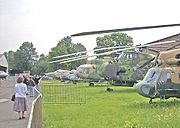
Aviation museum
Encyclopedia


Museum
A museum is an institution that cares for a collection of artifacts and other objects of scientific, artistic, cultural, or historical importance and makes them available for public viewing through exhibits that may be permanent or temporary. Most large museums are located in major cities...
exhibiting the history
History
History is the discovery, collection, organization, and presentation of information about past events. History can also mean the period of time after writing was invented. Scholars who write about history are called historians...
and artifacts of aviation
Aviation
Aviation is the design, development, production, operation, and use of aircraft, especially heavier-than-air aircraft. Aviation is derived from avis, the Latin word for bird.-History:...
. In addition to actual or replica aircraft
Aircraft
An aircraft is a vehicle that is able to fly by gaining support from the air, or, in general, the atmosphere of a planet. An aircraft counters the force of gravity by using either static lift or by using the dynamic lift of an airfoil, or in a few cases the downward thrust from jet engines.Although...
, exhibits can include photographs, maps
MAPS
Maps is the plural of map, a visual representation of an area.As an acronym, MAPS may refer to:* Mail Abuse Prevention System, an organisation that provides anti-spam support...
, models
Model (physical)
A physical model is a smaller or larger physical copy of an object...
, dioramas, clothing
Clothing
Clothing refers to any covering for the human body that is worn. The wearing of clothing is exclusively a human characteristic and is a feature of nearly all human societies...
and equipment used by aviators.
Aviation museums vary in size from housing just one or two aircraft to hundreds. They may be owned by national, regional or local governments or be privately owned. Some museums address the history and artifacts of space exploration as well, illustrating the close association between aeronautics
Aeronautics
Aeronautics is the science involved with the study, design, and manufacturing of airflight-capable machines, or the techniques of operating aircraft and rocketry within the atmosphere...
and astronautics
Astronautics
Astronautics, and related astronautical engineering, is the theory and practice of navigation beyond the Earth's atmosphere. In other words, it is the science and technology of space flight....
.
Many aviation museums concentrate on military or civil aviation, or on aviation history of a particular era, such as pioneer aviation, aircraft of World War II
World War II
World War II, or the Second World War , was a global conflict lasting from 1939 to 1945, involving most of the world's nations—including all of the great powers—eventually forming two opposing military alliances: the Allies and the Axis...
or a specific type of aviation, such as gliding
Gliding
Gliding is a recreational activity and competitive air sport in which pilots fly unpowered aircraft known as gliders or sailplanes using naturally occurring currents of rising air in the atmosphere to remain airborne. The word soaring is also used for the sport.Gliding as a sport began in the 1920s...
.
Aviation museums may display their aircraft only on the ground or fly some of them. Museums that do not fly their aircraft may have decided not to do so either because the aircraft are not in condition to fly or because they are considered too rare or valuable. Museums may fly their aircraft in air show
Air show
An air show is an event at which aviators display their flying skills and the capabilities of their aircraft to spectators in aerobatics. Air shows without aerobatic displays, having only aircraft displayed parked on the ground, are called "static air shows"....
s or other aviation related events, accepting the risk that flying them entails.
Some museums have sets of periodicals, technical manuals, photographs and personal archives. These are often made available to aviation researchers for use in writing articles or books or to aircraft restoration specialists working on restoring an aircraft.

